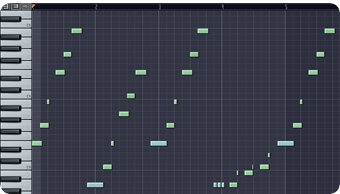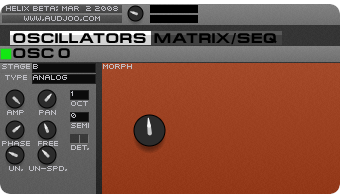Hook Composition 02
How much difference does one 8th note make? How much difference does one instrument make? In fact, they can make a huge difference! A big part of becoming a songwriter or becoming a music producer is learning how very small changes to an original idea can transform it dramatically. In our previous hook composition tip, we showed how learning and practicing basic exercises can lead directly to inspired melodies. We created a straightforward and effective melody, derived from minor arpeggios, that could be shaped into a powerful melodic hook with the right adjustments. Here, with our second hook compsition tip, we’ll show you how you can take that same melody to a whole new level in 2 separate ways with 1) by fine-tuning the rhythm and 2) by re-inventing the melody’s role in the mix.
1) Decide on a beat.
If you think one of your melodies could be improved, but you’re not sure how, nothing helps more than giving it context. What gives context? Deciding on a solid drum beat gives context. Imagine we’ve overlaid the melody from “Hook Composition 01″ with a steady moderato (moderate) beat: something with heavily-accented odd 8th notes, like a slow disco rhythm, for example - “Doom, tsss, ka, tsss, doom, tsss, ka …” The odd 8th notes are the “&”s of the beat if you’re counting “1 & 2 & 3 & …” (That’s the “tsss” of the above disco beat, or the open hi-hat). Against this beat, the melody as it appeared in “Hook Composition 01″ sounds a bit too stiff and mechanical - time to lay it back.
2) Analyze and refine the melody.
 To make the melody’s rhythm smoother, listen to the chosen beat, then listen to the melody, then listen to both tracks simultaneously using your music software. By first analyzing each music track separately, then re-analyzing both tracks mixed together, clues will emerge on what needs to change in the production. The accented odd 8th note from the drum track was begging for a stronger accent on the odd 8th notes of the melody from our first hook composition tip. By adding a beat, to give the melody context, we discovered a way to change it for the better. So what did we discover about the melody that needed to be changed? The odd 8th notes at the end of each bar of the melody from “Hook Composition 01″ (the “&” of every “4 &”) were empty. To fix that, we’ve moved some of the notes of the melody backward in the timeline by an 8th note to better match the beat. At left, the changes we’ve made to the melody are illustrated in blue. The notes that have changed from the original melody are the ones that
To make the melody’s rhythm smoother, listen to the chosen beat, then listen to the melody, then listen to both tracks simultaneously using your music software. By first analyzing each music track separately, then re-analyzing both tracks mixed together, clues will emerge on what needs to change in the production. The accented odd 8th note from the drum track was begging for a stronger accent on the odd 8th notes of the melody from our first hook composition tip. By adding a beat, to give the melody context, we discovered a way to change it for the better. So what did we discover about the melody that needed to be changed? The odd 8th notes at the end of each bar of the melody from “Hook Composition 01″ (the “&” of every “4 &”) were empty. To fix that, we’ve moved some of the notes of the melody backward in the timeline by an 8th note to better match the beat. At left, the changes we’ve made to the melody are illustrated in blue. The notes that have changed from the original melody are the ones that

previously landed on the bar line; now they precede the bar line by an 8th note. So the first notes of each 1-bar phrase begin an 8th note before the count of “1″ (except for the note at the beginning which kicks off the song). The notes are now arranged in a way that is smoother than the original concept. For consistency, we’ve also added two short staccato 16th notes that begin an 8th note before the breakdown starts at the 4th bar. Now the melody jives smooth and seamless with the beat. That’s the difference an 8th note can make.
3) Reuse and recycle.
 So how else can this melody improve? Well, it might need a new job. Let us explain. In any creative field, it’s easy to get attached to partial results without using them to their full potential. A writer, for example, might invent a great character in one story, but what if that character could be even better filling a extended role in a new story? The writer has to be flexible enough to re-invent older ideas. Musical creativity is the same. Though we wrote this melody in FL Studio for the tenor range using a Rhodes plugin, it would also make a deadly bassline. Always be willing to recycle old material in new places.
So how else can this melody improve? Well, it might need a new job. Let us explain. In any creative field, it’s easy to get attached to partial results without using them to their full potential. A writer, for example, might invent a great character in one story, but what if that character could be even better filling a extended role in a new story? The writer has to be flexible enough to re-invent older ideas. Musical creativity is the same. Though we wrote this melody in FL Studio for the tenor range using a Rhodes plugin, it would also make a deadly bassline. Always be willing to recycle old material in new places.
Above, is an oscillator section of the free Audjoo Helix synth (http://www.audjoo.com/), set to analog. In Helix, usually a combination of analog and sine waveforms with a bit of distortion yields a perfectly-flavored bass timbre. Try some of your own treble or tenor melodies as basslines by transposing them down a few octaves, and using a suitable bass timbre. You might discover the best bassline you’ve ever written. That’s the difference one instrument can make.
So, if a melody sounds too stiff, too awkward, or too flat, modify the melody’s rhythm and consider modifying it’s role in the mix. Beats and other song parts will provide you with clues about how the rhythm or role of the melody might need to change. In this case, the simple, yet popular rhythmic trick of playing notes one 8th note before the bar line proved a valuable rhythmic embellishment. This trick is particularly effective in melodies like the one above that consist mostly of 8th notes. Never be afraid to recycle your melodic hooks for new purposes. Maybe what you thought sounded good on piano sounds even better on guitar.
Finally, these are only two approaches to melodic creativity. They’re not the only approaches, and through our tips we’ll continue to expand your options. Until then, use your intuition, use the force. Listen carefully to all your favorite songs, practice your exercises and then try to “feel” the music when you expand on those exercises and begin to flex your creativity and improvization. Stay tuned for more! We’ve barely warmed up.







 GET 20% OFF COUPON INSTANTLY W/ SIGN-UP!
GET 20% OFF COUPON INSTANTLY W/ SIGN-UP!
 Check Out Hot Artists & Music Producers discovered through Song Submit!
Check Out Hot Artists & Music Producers discovered through Song Submit!



can i make a beat
Yo Lildell,
Behind your succinctly-worded question, we hear your drive and determination to get in the game and get producing. Of course you can make a beat! And yo, one of the best ways is to slice and arrange samples. In fact, our “Widen Your Drum Beats” tip (https://www.modernbeats.com/hit-talk/widen-your-drum-beats/) shows a great basic model of drum beat arrangement, plus it’s got great tips on widening the mix.
I would like to know about pitch bending. Nowadays, all musicians are using one pitch bend effect on voices and also on instruments, which bends the pitch and notes very quickly and dramatically. Which is that plugin? Can I download it ?
Madhuchandra, I think you mean Autotune, available from the Antares Autotune website
I have a question. What did R&B originate from?
What Type of Piano Lessons do I have to take if I want to produce R&B?
The Mark Harrison books are supposed to be pretty good, Emmanuel. (Published by Hal Leonard)
I took a look at the Mark Harrison Music website but, it didn’t really answer my question. I was looking for what type a piano lesson do I have to take in order to produce R&B. I’m trying to find a local piano lesson teacher in my home town so that can prepare to take real piano lessons.
Do you think I would have to take Jazz and Blues piano lessons in order to do todays Contempory R&B Music?
Thank you
we’re sure most piano teachers could guide you appropriately, Emmanuel.